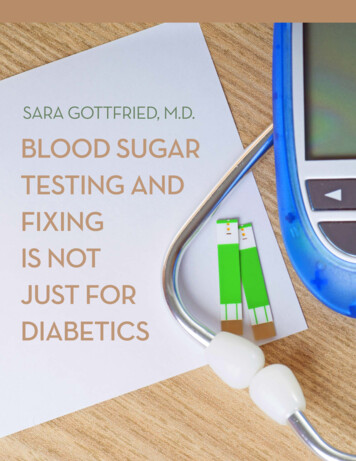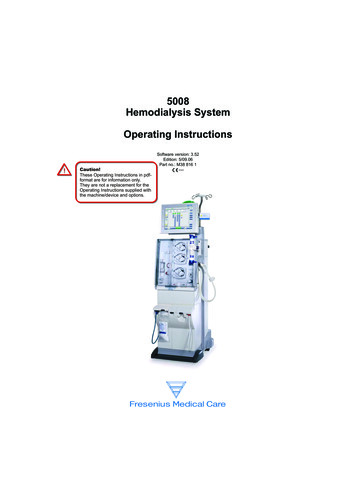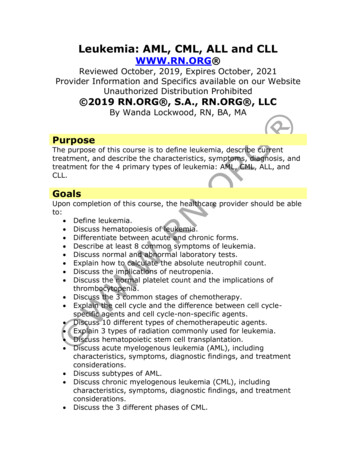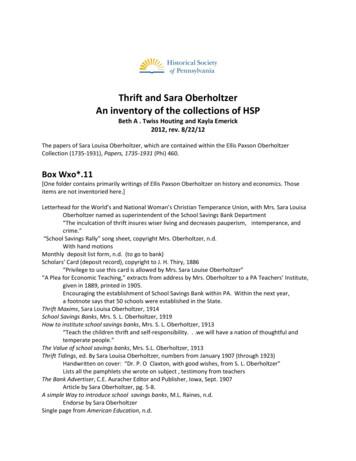
Transcription
SARA GOTTFRIED, M.D.BLOOD SUGARTESTING ANDFIXINGIS NOTJUST FORDIABETICS
BLOOD SUGAR TESTING AND FIXING IS NOT JUST FOR DIABETICSNOT JUST FOR DIABETICS:TEST RESET YOUR BLOOD SUGARFeel fat or sluggish? It may not be YOU; it may be your glucose level and how it interactswith a hormone called insulin. When the relationship is off, you will have high insulin levels,followed by high glucose levels, and your cells will become numb to insulin. That is calledinsulin resistance, and it makes you feel fat and foggy, even if you don’t meet the diagnosticcriteria for type 2 diabetes.I find that measuring my fasting glucose is an incredibly helpful metric. When I was a chunkymonkey and stress-crazed working mom in my thirties, I discovered that my fasting glucosewas 110. I was stunned because I was heading toward diabetes. Iturned my problem with glucose around in 72 hours, and youcan too.There are many ways to reset your insulin, and I wroteextensively about it in my New York Times bestsellingbook, The Hormone Reset Diet.When you reset insulin so you are sensitive to itagain, you create hormonal harmony. Estrogen andprogesterone work better. Testosterone is back onyour side. Leptin and your sense of satiety may returnto normal. Your waist gets slimmer. Yay!To your best fasting glucose!Dr. Sara Gottfried MD COPYRIGHT 2015 GOTTFRIED INSTITUTE2WWW.SARAGOTTFRIEDMD.COM
BLOOD SUGAR TESTING AND FIXING IS NOT JUST FOR DIABETICSTurn Your Insulin into Jillian Michaels (Part 1):Test Your Blood SugarI think of insulin as the “Jillian Michaels” hormone. When it’s in the target zone, it’s awondrous model of human engineering.But the rest of us have the non-Jillian Michael’s version. The rest of us have a little um, let’scall it sluggishness when it comes to insulin. Insulin knocks on the door of our cells, andwe can’t be bothered to deal. But as Jillian says:“The past does not define you; the present does.”It’s time to redefine your dance with glucose andinsulin.Is Your Pancreas the Biggest Loser?Most of us have heard of insulin and blood sugar,but don’t really understand how they work.Think of them this way. Your pancreas producesinsulin, the hard-working/Jillian Michaels hormonethat seeks out glucose and turns it into usefulenergy. Glucose is sugar, floating around in yourbloodstream but any glucose that doesn’t getused up by insulin eventually gets stored as fat for“later.” While your pancreas tries to match your insulin levels with your glucose, sometimes itcan’t keep up.Your insulin-producing pancreas is all business, rather like Jillian Michaels: harnessing thesluggish and over-sugared, and turning us into lean, energy-filled machines. The problem isthat when we have chronically high blood sugar, even the toughest little fireball of a pancreascan’t produce enough insulin to bring glucose levels down. And even if it can, after monthsand years of flooding your system with insulin it goes numb, leading to insulin resistance and then high blood sugar once again.Blood But Not Sweat and TearsThe good news? You can bring down your blood sugar levels and reverse insulin resistance.All it takes is a little lifestyle tweaking and a little insight from the oh-so-handy tool: theglucometer. Seeing your elevated blood sugar levels on the screen may be all the motivationyou need to cut out some carbs and add some exercise.Testing your blood sugar, especially your fasting blood sugar (first thing in the morningbefore you eat breakfast), provides insight into your insulin sensitivity and your blood glucoselevels. Since both are great indicators of overall health, I’m going to explain how you canadminister this simple test yourself. COPYRIGHT 2015 GOTTFRIED INSTITUTE3WWW.SARAGOTTFRIEDMD.COM
BLOOD SUGAR TESTING AND FIXING IS NOT JUST FOR DIABETICSGear up!You can pick up a glucometer at any pharmacy – Target, CVS, Walgreens, or online – withouta prescription. OneTouch is a popular, reliable brand that sells their compact OneTouch UltraMini for under 20 on Amazon. That’s what I use each morning.Along with a glucometer (sometimes simplycalled a “meter”), you’ll also need a lancing device(almost all glucometers come with their own),lancets, and test trips.Some glucometers come with a small supply oftest strips, but you’ll probably want to buy more soyou can collect blood sugar data for at least a fewweeks. Make sure that the test strips you buy arecompatible with your glucometer! For example:If you buy a OneTouch glucometer, you’ll wantto pick up some OneTouch Test Strips too. You’llalso need lancets to go inside your lancingdevice (again, most meters come with a smallintroductory supply).In review, here’s what you need: Glucometer Test strips Lancing device Lancets Control solution (optional)Set Up Your MeterIf it’s your first time using your meter, you’ll need to set it up. This may include the following: Setting date and time Matching the test strip number to the meter’s settings (not necessary for all meters). Onceyou insert a test strip into the meter, simply make sure the number on the screen matchesthe number on the vial of strips. Use the meter’s buttons to adjust if necessary. Calibrating the meter usinga test strip and controlsolution (again, not alwaysa required step)Look, I ain’t on no ra-ra shit.You don’t wanna test how far Miss get.— Chinese Man, Miss Chang COPYRIGHT 2015 GOTTFRIED INSTITUTE4WWW.SARAGOTTFRIEDMD.COM
BLOOD SUGAR TESTING AND FIXING IS NOT JUST FOR DIABETICSTest Your Blood SugarThe fun part!Step 1. Wash your handsSome doctors recommend using an alcohol swab, but it’s been shown that the alcohol onyour finger tips can throw off the test results. Soap and water works perfectly fine.Step 2: Insert a test stripPut a test strip in your meter; one end of the test strip fits into a slot in the meter, and theother will have a narrow channel on it for the blood sample. After you’ve inserted it, watchthe screen for the icon that signals it is ready for testing.Step 3: Prick your fingerTo stick around you must be crazy,Go on, let it bleed.— Leona Lewis, TroubleMost meters use a drop of bloodfrom your fingertip, althoughsome are approved for palm orforearm use. See the instructionsincluded with your meter.Put a new lancet in your lancing device and put the cap back on. If you have sensitivefingertips, set the lancing depth to a low number (1-2). If you have callused fingertips, you willneed to set the number a bit higher in order to get a drop of blood to appear.Cock the lancing device and hold the cap of the lancing device against the side of yourfinger. Squeeze the trigger and the lancet will pierce your skin. If needed, squeeze yourfingertip until a small drop of blood appears. You don’t need much, and it won’t hurt toomuch. As Jillian says Step 4: Add your blood sample to the test stripHolding the meter and strip at aright angle to you finger, gentlyhold the strip against the drop ofblood. The blood should easilyfill the length of the channelwhile your meter waits.“Do I look like the kind of personwho gives a sh*t?”— Jillian MichaelsMost meters can sense when the strip makes contact with blood. If the blood doesn’t makeit to the end of the channel for any reason, you will get an error message on the screen andwill have to start over with a new test strip. It happens to all of us.Step 5: Get resultsOnce the blood sample has filled the test strip channel, your meter will need a few secondsto process. Next, your blood glucose level will display on the screen. You did it! COPYRIGHT 2015 GOTTFRIED INSTITUTE5WWW.SARAGOTTFRIEDMD.COM
BLOOD SUGAR TESTING AND FIXING IS NOT JUST FOR DIABETICSMost new meters have a large memory and the ability to import the data into your computerusing a USB cord. Feel free to go full biohacker and track your blood glucose highs and lowsover weeks and months! Charts! Logs! I love it!Step 6: Clean up.Dispose of your used lancet and test strip in a biohazard container or a thick plastic jug with alid, like an old juice container.Ideally, you want your fasting blood sugar to be between 70-85 mg/dL (3.9-4.7 mmol/L). Alsoconsider testing your post-prandial blood sugar two hours after a meal, which you want tobe between 70-99 mg/dL (3.9-5.5 mmol/L).Turn Your Insulin into Jillian Michaels (Part 2):Fix Your Blood SugarMeasuring your blood sugar, especially your fasting blood sugar, gives you valuable insightinto your insulin resistance and your overall health. If, like most of us, your blood sugar isa little high (the optimal range is ), then it’s time to start addressing the root cause. You’vetaken an important first step when it comes to managing your weight, cortisol, and insulinsensitivity But it’s time to take the next step.Now it’s time to actively change your diet, your exercise habits and your supplement strategy.Here’s how:Cortisol ControlCortisol regulates your blood sugar, your immune function and your blood pressure. Theproblem is, most of us don’t regulate our cortisol. Cortisol works by releasing a quick burstof glucose into your system. This is important when you need to wake up in the morning or,say, run away from a tiger, but it’s not very helpful when it comes to an busy job or financialworries. Chronically-high cortisol leads to chronically-high blood sugar. Here are some ofmy favorite ways to keep cortisol at healthy levels: Take fish oil Cut down on caffeine Chanting and deep breathing (great for an in-the-car relaxation session!) Reduce alcohol to 2-3 servings per week Eat dark chocolate (Doctor’s orders) Add Vitamin B5 or Vitamin C to your daily routine COPYRIGHT 2015 GOTTFRIED INSTITUTE6WWW.SARAGOTTFRIEDMD.COM
BLOOD SUGAR TESTING AND FIXING IS NOT JUST FOR DIABETICSExcellent ExerciseExercise is one of the best ways to loweryour blood sugar and increase yourinsulin sensitivity. What most peopledon’t know is that certain types of highimpact exercise (like running) actuallyincrease cortisol, and as a result, bloodsugar. The following are some of myfavorite ways to burn some calories andbeat blood sugar. Yoga Pilates Power walking (just add girlfriends foran added boost of oxytocin) Burst or high-intensity interval trainingFabulous FoodDiet may be the most obvious – and the most effective – way you can positively affect yourblood sugar levels. You have to eat to live, but choosing your foods based on your body’sneeds can help you live a lot longer. Below are the best ways to adjust your diet in a way thatkeeps your blood sugar low and steady. Don’t drink your calories: commercial juices and coffee shop drinks are serious sugarbombs. Cut out sugar wherever possible, including artificial sweeteners. Add fiber. Not only will fiber keep you fuller longer, but it will also help flush toxins out ofyour body. Become a whole foodist. Adding lots of fruits and vegetables to your diet doesn’t just addvitamins and minerals – it keeps your carbohydrate count low and your fiber high.Low Sugar Habits High Quality LifeRegularly measuring your blood sugar as well as following the guidelines above will help youkeep your glucose levels steady as well as maintain your insulin sensitivity. Eating the SAD(Standard American Diet), exercising every now and then, and suffering chronic stress canlead to hard-to-lose belly fat, low energy and even Type 2 diabetes. Managing your bloodsugar and you’ll be rocking your mission into your golden years and beyond.To learn more about Dr. Sara Gottfried, visit her website, SaraGottfriedMD.com. Check outher delicious, hormone resetting shakes and other products at RESET360.com. COPYRIGHT 2015 GOTTFRIED INSTITUTE7WWW.SARAGOTTFRIEDMD.COM
BLOOD SUGAR TESTING AND FIXING IS NOT JUST FOR DIABETICSAbout Dr. SaraSara Gottfried, MD is the New York Times bestselling author ofThe Hormone Cure and The Hormone Reset Diet. After graduatingfrom Harvard Medical School and MIT, Dr. Gottfried completed herresidency at the University of California at San Francisco. She is aboard-certified gynecologist who teaches natural hormone balancingin her novel online programs so that women can lose weight,detoxify, and slow down aging. Dr. Gottfried lives in Berkeley, CAwith her husband and two daughters.Medical DisclaimerInformation provided in this document is for informational purposes only. The informationis a result of years of practice and experience by Sara Gottfried, MD. However, thisinformation is NOT intended as a substitute for the advice provided by your physicianor other healthcare professional, or any information contained on or in any productlabel or packaging.Do not use the information provided in this document for diagnosing or treating ahealth problem or disease, or prescribing medication or other treatment. Always speakwith your physician or other healthcare professional before taking any medication ornutritional, herbal or homeopathic supplement, or using any treatment for a healthproblem. If you have or suspect that you have a medical problem, contact yourhealth care provider promptly. Do not disregard professional medical advice or delayin seeking professional advice because of something you have read in this document.Information provided in this document and the use of any products or services relatedto this document by you DOES NOT create a doctor-patient relationship between youand Sara Gottfried, MD. Information and statements regarding dietary supplementshave not been evaluated by the Food and Drug Administration and are notintended to diagnose, treat, cure, or prevent any disease. COPYRIGHT 2015 GOTTFRIED INSTITUTE8WWW.SARAGOTTFRIEDMD.COM
glucometer. Seeing your elevated blood sugar levels on the screen may be all the motivation you need to cut out some carbs and add some exercise. Testing your blood sugar, especially your fasting blood sugar (first thing in the morning before you eat breakfast), provides insight int










